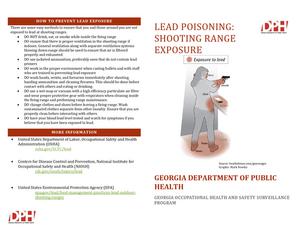HOW TO PREVENT LEAD EXPOSURE
There are some easy methods to ensure that you and those around you are not exposed to lead at shooting ranges.
DO NOT drink, eat, or smoke while inside the firing range DO ensure that there is proper ventilation in the shooting range if
indoors. General ventilation along with separate ventilation systems blowing down-range should be used to ensure that air is filtered properly and exhausted. DO use jacketed ammunition, preferably ones that do not contain lead primers DO work in the proper environment when casting bullets and with staff who are trained in preventing lead exposure DO wash hands, wrists, and forearms immediately after shooting, handing ammunition and cleaning firearms. This should be done before contact with others and eating or drinking. DO use a wet mop or vacuum with a high efficiency particulate air filter and wear proper protective gear with respirators when cleaning inside the firing range and performing range maintenance. DO change clothes and shoes before leaving a firing range. Wash contaminated clothes separate from other laundry. Ensure that you are properly clean before interacting with others. DO have your blood lead level tested and watch for symptoms if you believe that you have been exposed to lead.
MORE INFORMATION
United States Department of Labor, Occupational Safety and Health Administration (OSHA) osha.gov/SLTC/lead
Centers for Disease Control and Prevention, National Institute for Occupational Safety and Health (NIOSH) cdc.gov/niosh/topics/lead
United States Environmental Protection Agency (EPA) epa.gov/lead/best-management-practices-lead-outdoorshooting-ranges
LEAD POISONING: SHOOTING RANGE EXPOSURE
Source: Seattletimes.com/gunranges Graphic: Mark Nowlin
GEORGIA DEPARTMENT OF PUBLIC HEALTH
GEORGIA OCCUPATIONAL HEALTH AND SAFETY SURVEILLANCE PROGRAM
WHAT IS LEAD POISONING? Lead is a metal found naturally in the earth's crust. However, lead that enters the environment (i.e. air, soil, water, homes, etc.) through human activities and usage is toxic. Lead poisoning occurs when there is a buildup of lead in the body that can cause severe health problems. In the past, lead was used in everyday household items such as kitchen appliances and children's toys. It was also a common additive for gasoline and paint. Even though lead is hazardous to humans, it is still frequently used today in jobs such as manufacturing and construction. In addition, individuals can be exposed through activities like refinishing furniture, renovating old buildings, and going to shooting ranges.
SYMPTOMS OF LEAD POISONING Lead can enter a person's body by breathing lead dust into the lungs or by swallowing lead dust that settled on hands or surfaces that were not adequately cleaned/washed. Once in the body, lead can damage almost every organ system and cause many different health effects.
ADULT SYMPTOMS OF LEAD POISONING If an adult has elevated blood lead levels (5 g/dL or higher), they can experience the following symptoms: High blood pressure Abdominal pain Joint and muscle pain Pain or numbness of the extremities Headache Fatigue Constipation Miscarriages or pre-mature birth in pregnant woman
Graphic: Mark Nowlin, The Seattle Times
LEAD EXPOSURE Shooting ranges are an occupational necessity for those who have careers in security, law enforcement, and the military. They also provide a growing recreational activity for the public. Understanding how lead exposure can occur at shooting ranges and how to prevent exposure is important for the health and safety of you and those around you.
HOW DOES EXPOSURE OCCUR? You can be exposed to lead at a shooting range from the airborne lead dust that comes from using ammunition containing lead. In addition, individuals in a shooting range can be exposed to lead dust from the smoke released in the air when a gun is fired or from the lead that settles unto the floor and shelves at indoor shooting ranges. A standard bullet contains a lead core that is wrapped in some sort of jacket usually made of copper. When fired, the lead particles in the bullet come out near the firing pin and are included in the gunshot residue that comes out of the ejection port.
Source: Seattletimes.com/gunranges Graphic: Mark Nowlin
If an individual eats, drinks or smokes at a shooting range, they can also ingest lead dust. In addition, a worker can expose those they interact with after visiting a shooting range such as their family and friends. This occurs when individuals carry lead home on their skin, clothing, and shoes. If not cleaned properly, this lead can be passed to others.
